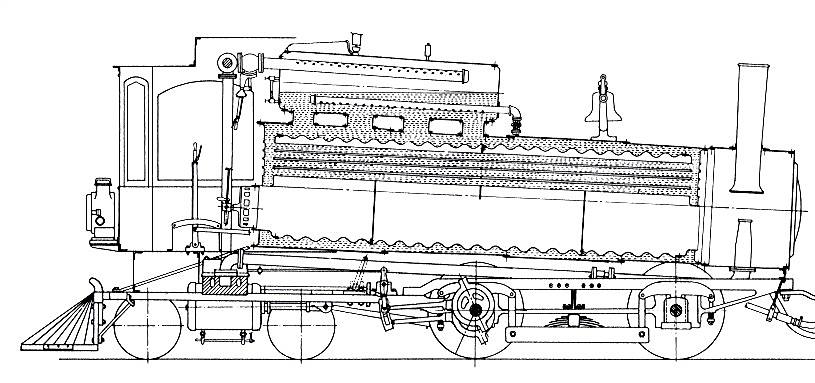Opened: 10 Nov 2008
Updated: 12 Nov 2008




The North Pacific Coast Locomotive
|
Opened: 10 Nov 2008 |
The NPC No 21 was a radical experiment in locomotive design, carried out by Bill Thomas, chief engineer of the NPC; the exact date of building is a little unclear but appears to be 1901. It was an oil-fired cabforward design with a marine-type water-tube boiler, and carried a big and cumbersome-looking horizontal steam drum above the boiler instead of a steam dome. The construction used the running gear and frame from a wrecked Baldwin 4-4-0. The tender was equally unusual; it was a flat car with vertical tanks for oil and water. The locomotive was called "Thomas Stetson".
It has been stated that Bill Thomas took out a patent for the design, but a search of US patents has not found it.
It was not a beautiful locomotive.
Unfortunately it was not a successful one either. It suffered from a lack of adhesion weight, and the oil burners were too close to the water tubes, causing them to be damaged. Its ultimate fate is currently unclear, but it was probably scrapped when the NPC was sold to the North Shore Railroad on March 7, 1902.
The boiler can be seen to consist of a long corrugated furnace with some water tubes at the top. I haven't attempted any calcultions but it looks to me as though the evaporative surface would be considerably less than that of a conventional fire-tube boiler. The boiler was completely full of water, the steam space being in the steam drum above. Because of the large furnace, it appears that the boiler would hold much less water than a conventional type, and this may have been the cause of the lack of adhesion weight
 Above: The NPC No 21 "Thomas Stetson" on trial, with Bill Thomas at the controls.
Above: The NPC No 21 "Thomas Stetson" on trial, with Bill Thomas at the controls.
 Above: A section of NPC No 21 "Thomas Stetson".
Above: A section of NPC No 21 "Thomas Stetson".
In the steam drum can be seen a lower perforated pipe for boiler feed, and an upper perforated pipe for steam collection. A whistle was mounted on the side of the drum; a water gauge can be seen on the front of the drum. From the drum the steam passed through a regulator valve and then to the cylinders via two big vertical pipes in the cab. A pipe or pipes carried the exhaust to the rear of the boiler and to a conventional blast-pipe.



